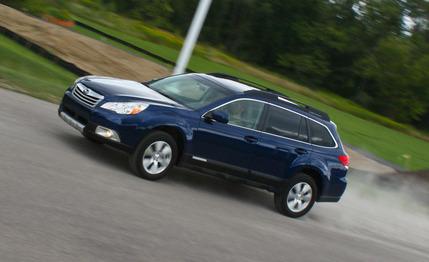
 Short Take Road Test
Short Take Road Test
Let’s get one thing straight, right here at the top: The “R” in the model designation does not stand for race.


The new Outback, generation four dating to 1994, is not a ride that’s likely to stimulate your inner racer. This is family transportation, and 15 minutes behind the wheel will be enough to convince you that whatever sport you might associate with the vehicle is the equipment you loaded on the roof rack or into the rubber-floored cargo well at the back.
But neither does “R” stand for retardo—Spanish for “slow as hell,” or something like that. Not with the optional 3.6-liter flat-six providing propulsion. The 3.0-liter H-6 option in the previous Outback 3.0R made forward progress an exercise in patience. It’s a different story here.
Although the latest Outback is bigger in every dimension but length, the development team has done an excellent job of keeping weight in check. Our test subject, a top-of-the-line Limited model, scaled in at 3651 pounds. As with all Subies, that curb weight includes standard all-wheel drive. For contrast, consider the mass of two five-passenger competitors with similar dimensions: An all-wheel-drive Mazda CX-7 weighs in at about 3900 pounds, with a Chevrolet Equinox coming in at more than 3700 with only front-wheel drive.
More Muscle to Move the Modest Mass
Introduced with the Tribeca, Subaru’s three-row crossover SUV, the 3.6-liter flat-six doesn’t make much more horsepower than the 3.0—256 versus 245—but it’s much more of a torque generator: 247 lb-ft compared with 215. Better yet, the torque curve has a profile similar to the airport butte in St. George, Utah—long and flat. Subaru claims 225 lb-ft are on tap from 2000 to 6000 rpm, and we believe it.
With a five-speed automatic sending power to the all-wheel-drive system—the torque split is 45 percent front, 55 rear in normal operation—the 3.6R hit 60 mph in 7.4 seconds and covered the quarter-mile in 15.7 at 90 mph.
There’s obviously no danger of nosebleeds or acceleration g-load brownouts with numbers like that, but this is a much livelier pace than the 3.0R was capable of producing. And passing performance, something that required careful planning with the previous flat-six, is much more carefree and spontaneous. The transmission kicks down readily, and the Outback surges forward with a will.
Transmission Omission?
Ah, yes, the transmission. Subaru actually offers three transmissions for the Outback. Buyers who settle on the 2.5i model can choose between a six-speed manual (standard) or an optional new chain-driven continuously variable transmission, a first for an all-wheel-drive application.
Outbacks equipped with the new H-6 are limited to the five-speed automatic. It’s a smoothie in ordinary operation, but the manual function using the wheel-mounted paddle shifters isn’t particularly satisfying. Shifts are a little soggy, and the transmission upshifts on its own a couple hundred rpm before the 6500-rpm redline. Considering this vehicle’s family-oriented mission and the uninspiring performance of the paddle-shift system, Subaru could well have saved some money by omitting such frivolities from the inventory. And we’d gladly swap the paddles for a sixth gear, something the CX-7 and the Equinox include in their auto-only drivetrains.
Dynamic Certainty
As we said, no one is likely to consider this Subaru to be racy, but it’s unlikely to provoke dismay with any handling quirks. There’s a fair amount of body roll—the trade-off for supple ride quality on all but the gnarliest surfaces—and the variable-assist rack-and-pinion steering is a little slow at 3.2 turns lock-to-lock.
Even so, the Outback recovers well in quick transitions and is absolutely devoid of surprises. Inevitably, there’s progressive understeer, and it’s not difficult to provoke squeals of protest from the 60-series tires (225/60-17), a taller profile selected for ride-quality benefits.
But there is never an instant of uncertainty in this vehicle’s responses, and anyone who plants an Outback among the roadside greenery—overcoming an effective (and not completely defeatable) stability control—has done so by a Darwin Award level of incompetence.
Capacious, Quiet Cabin
Whereas the 3.6R delivers a respectable level of performance—and decent fuel economy (an EPA-rated 18 city/25 highway mpg) burning regular fuel (the 3.0 required premium)—the Outback’s greatest strengths are quiet operation and the expanded space in its handsomely appointed cabin.
Although we noted a nasty chassis buzz on washboard stretches of graded road, as well as an occasional shudder through the unibody on some of the bigger bumps, the Outback’s basic pavement deportment is almost beyond reproach.
The civilized dynamics are augmented by the voluminous interior. The Outback’s overall length is actually slightly diminished, but the wheelbase, the width, and the height have all increased, yielding rear leg- and headroom capable of a strong comfort rating from all but the tallest of the current NBA tribe, as well as a good-size cargo hold.
Our test subject was a top-of-the-line Limited model that rang in at $34,685 with navigation and a power sunroof. Its base price is $31,690. You can get into a new Outback for considerably less—the base 3.6R starts at $28,690, and a 2.5i is $23,690—but it’s worth noting that the base price for the 3.6R Limited is actually a little less than for the outgoing 3.0R Limited, and it’s also less than the top version of the Mazda and only about $1000 more than the highest-spec Equinox.
It may not be a thrill-a-minute ride, but the vehicle Subaru characterizes as the progenitor of the crossover phenomenon remains one of the key players in that rapidly expanding game.